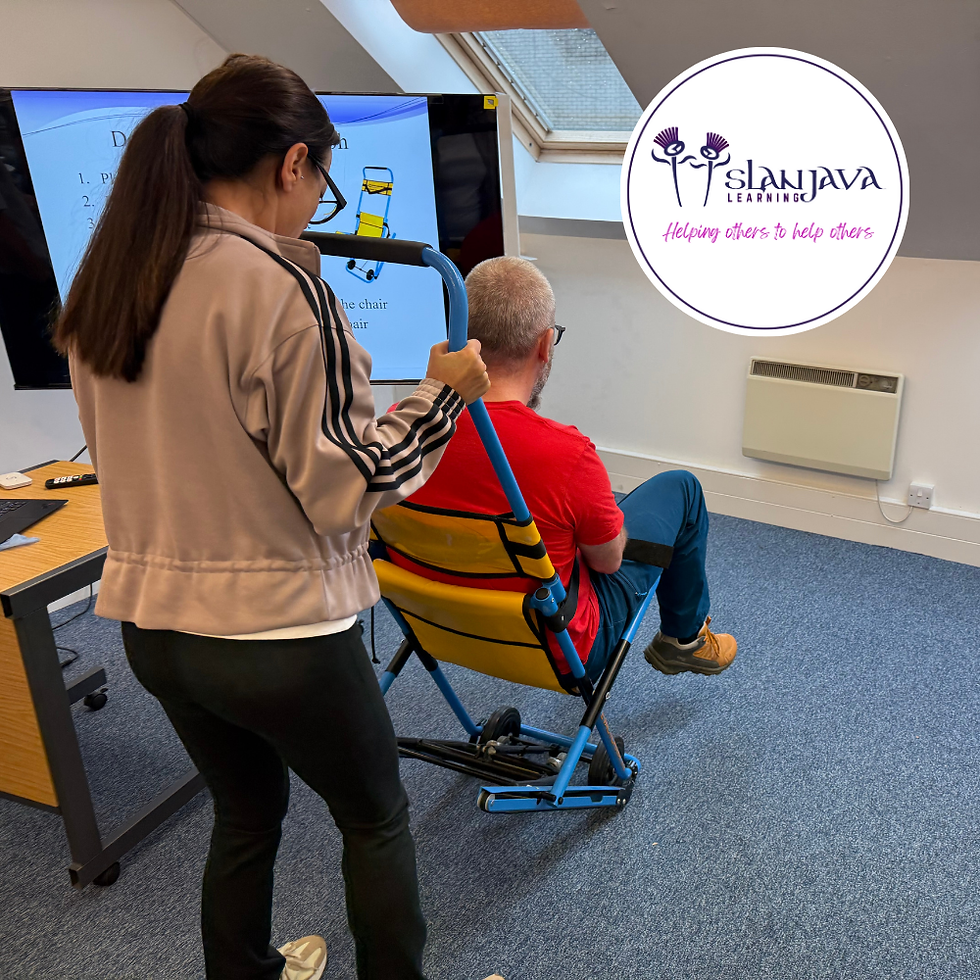The Importance of Evacuation Chair Training in the Workplace
- Slanjava Learning Ltd.

- Oct 4
- 3 min read
When an emergency strikes, safe and timely evacuation is vital. For individuals with mobility challenges, evacuation chairs provide a life-saving solution by ensuring no one is left behind during a fire, power outage, or other emergency. But simply having an evacuation chair on-site is not enough, staff must be trained and confident in using it.
At Slanjava Learning Ltd, we specialise in providing training services and solutions, including our CPD accredited Evacuation Chair Train the Trainer course, equipping organisations with the knowledge and skills to support safe, more inclusive evacuations.
Why Evacuation Chair Training Matters
An evacuation chair is designed to help safely move individuals who may not be able to use stairs in an emergency. This includes people with:
Reduced mobility
Long-term health conditions
Temporary injuries
Or anyone who may find stairs difficult in a crisis.
Without proper training, staff may be unsure how to operate the chair or may risk injury to themselves and hte individuals they are assisting. Training ensures confidence, competence and compliance.

Legal and Compliance Considerations
Under UK legislation, empolyers and building owners are required to ensure safe evacuation for all individuals. Key frameworks include:
Equality Act 2010 – requires organisations to make reasonable adjustments for people with disabilities, including emergency evacuation planning.
Fire (Scotland) Act 2005 and Fire Safety (Scotland) Regulations 2006 – place duties on employers and dutyholders to ensure safe evacuation procedures.
Regulatory Reform (Fire Safety) Order 2005 (England & Wales) – places duties on the ‘responsible person’ to ensure fire safety measures, including safe evacuation, are in place.
Health and Safety Executive (HSE) – stresses the importance of training and planning for all foreseeable risks, including emergencies.
Failure to plan for safe evacuation can result in legal consequences, reputational damage, and—most importantly—serious harm.
What Does Evacuation Chair Training Cover?
A structured evacuation chair training course typically includes:
Understanding the purpose and design of evacuation chairs.
Legal duties and responsibilities of employers and staff.
Safe operating techniques for chair models.
Practical, hands-on training in moving individuals safely.
Risk assessment and communication during emergencies.
For organisations with multiple sites or teams where staff roles and responsibilities change regularly, a Train the Trainer programme can be one of most effective options. It enables designated staff to deliver evacuation chair training internally, helping to maintain competence across the workforce while being both sustainable and cost-effective.
Evacuation Chair Train the Trainer
Our CPD Evacuation Chair Train the Trainer course gives delegates the confidence and resources to deliver evacuation chair training within their own organisations. Covering multiple chair types, this course is ideal for health and social care, education, hospitality, and corporate settings.
Benefits include:
Meeting compliance requirements.
Building in-house expertise.
Ensuring continuity of knowledge across teams.
Promoting safer, more inclusive workplaces.

Frequently Asked Questions
Do all buildings need an evacuation chair?
If your premises have stairs and may be used by people with mobility challenges, an evacuation chair should be part of your emergency planning.
How often should staff be trained?
Best practice is to refresh formal evacuation chair training every three years, or sooner if new equipment is introduced or staff responsibilities change. Alongside this, organisations should also schedule regular practice sessions (for example, during fire drills) to ensure staff remain confident and capable in real situations.
Can one person use an evacuation chair?
Yes, many models are designed for single-user operation, but staff must be trained in correct techniques to ensure safety.
Why Choose Slanjava Learning Ltd.?
At Slanjava Learning Ltd., our mission is simple: helping others to help others. With accredited training, experienced instructors, and a commitment to inclusivity and safety, we support organisations across Scotland and the wider UK to meet their evacuation responsibilities.
As part of our sustainability efforts, we also plant a tree for every course booking in partnership with Just One Tree.
Take the Next Step
Don’t wait for an emergency to test your preparedness. Invest in evacuation chair training today to ensure the safety and confidence of your team.
Interested in learning more? Get in touch by calling 0141 459 0894 or emailing hello@slanjavalearning.co.uk
Kind regards,
Slanjava Learning
-slàinte mhath-











Comments